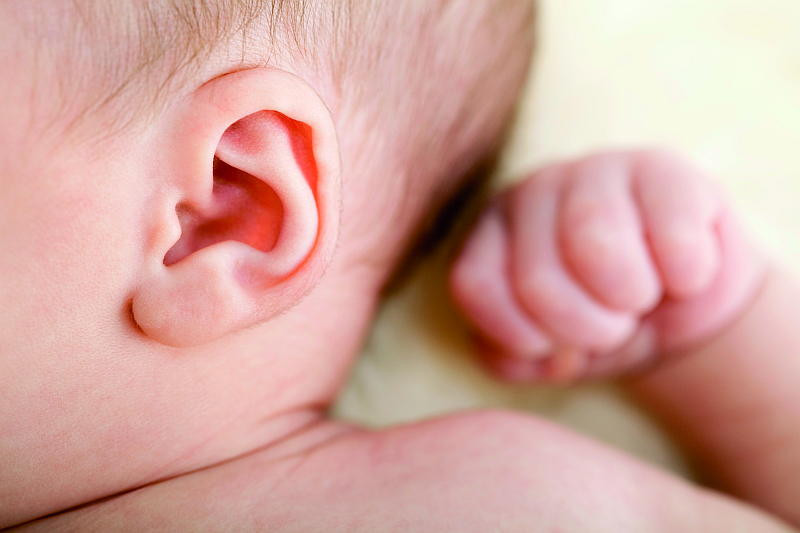Definisi
Telinga terdiri atas tiga bagian utama, yaitu telinga bagian luar, telinga bagian tengah dan telinga bagian dalam. Getaran suara akan dihantarkan atau berkonduksi dari telinga luar, melewati telinga tengah, menuju ke telinga dalam kemudian dihantarkan menuju ke otak. Getaran suara tersebut akan dipresentasikan di otak, sehingga dapat dimengerti oleh pendengarnya.
Jika terjadi gangguan pada telinga bagian luar dan bagian tengah, hal ini dapat menyebabkan terhambatnya penghantaran suara menuju ke telinga bagian dalam dan ke otak. Lebih lanjut, kondisi ini dapat menyebabkan gangguan pada pendengaran. Kondisi ini disebut sebagai tuli konduktif.
Gangguan yang terjadi pada kasus tuli konduktif sering kali diakibatkan karena adanya penyumbatan atau kerusakan pada bagian luar atau telinga bagian tengah Anda. Kondisi ini akan menyebabkan suara sulit untuk mencapai telinga Anda. Jika Anda mengalami tuli konduktif, Anda akan cenderung mengalami kesulitan saat mendengar suara yang bervolume kecil dan halus. Tuli konduktif dapat bersifat sementara atau permanen, tergantung penyebab terjadinya.
Penyebab
Pada kondisi hilangnya pendengaran atau tuli konduktif, getaran suara tidak dapat mencapai telinga bagian dalam. Hal ini dapat terjadi sebagai komplikasi dari gangguan pada telinga bagian luar dan telinga bagian tengah.
Gangguan telinga luar yang dapat menyebabkan tuli konduktif, berupa:
- Benda kecil atau serangga yang terjebak dalam saluran telinga tengah Anda, baik telinga bagian luar atau telinga bagian tengah,
- Menumpuknya kotoran telinga pada saluran telinga Anda,
- Adanya kelainan lesi pada tulang yang tumbuh dan menyumbat pada telinga Anda,
- Adanya infeksi pada saluran telinga Anda,
- Adanya penumpukan cairan dalam telinga Anda,
- Adanya kelainan struktur pada saluran telinga Anda,
- Terjadinya penyempitan pada saluran telinga Anda.
Komplikasi pada telinga tengah Anda yang dapat menyebabkan terjadinya tuli konduktif berupa:
- Infeksi pada telinga bagian tengah dan penumpukan cairan pada telinga Anda,
- Adanya cedera pada membrane timpani atau gendang telinga Anda,
- Adanya lubang pada pada gendang telinga Anda,
- Adanya tekanan pada telinga Anda yang menyebabkan kolapsnya gendang telinga Anda,
- Penebalan gendang telinga,
- Pertumbuhan secara berlebihan pada sel kulit di telinga bagian tengah Anda,
- Kerusakan pada tulang di telinga tengah,
- Kondisi bawaan seperti otosklerosis yang menyebabkan tulang telinga tengah mengalami kelainan dan membentuk penyumbatan pada telinga.
Faktor Risiko
Terdapat beberapa faktor risiko yang dapat meningkatkan kemungkinan terjadi tuli konduktif, yaitu:
- Sering mengalami infeksi telinga,
- Anda sering membersihkan telinga dengan menggunakan cotton bud atau benda kecil lainnya yang dapat menyebabkan kerusakan pada gendang telinga,
- Berenang,
- Telinga Anda lembab berlebihan dalam jangka waktu yang lama,
- Paparan air yang mengandung bakteri dengan konsentrasi tinggi pada telinga Anda.
Gejala
Pada umumnya, jika Anda mengalami gangguan tuli konduktif, Anda akan mengalami kesulitan untuk mendengar suara bervolume kecil dan cenderung halus. Kondisi ini akan membuat Anda sering membesarkan volume suara pada handphone, televisi, atau speaker yang sedang Anda gunakan.
Terdapat beberapa gejala lain yang bisa terjadi jika Anda mengalami tuli konduksi. Beberapa di antaranya berupa:
- Gangguan pendengaran yang terjadi secara mendadak,
- Hilangnya pendengaran yang terus mengalami perburukan seiring dengan waktu berjalan,
- Adanya rasa nyeri pada salah satu atau kedua telinga Anda,
- Pusing,
- Adanya aroma aneh atau tidak sedap yang keluar dari dalam telinga Anda,
- Keluarnya cairan dari telinga Anda.
Diagnosis
Anamnesis
Dokter akan mengajukan beberapa pertanyaan tentang riwayat kesehatan Anda dan gangguan pendengaran yang Anda rasakan.
Pemeriksaan Fisik
Dilakukan pemeriksaan fisik untuk mengetahui adanya kelainan yang dapat terjadi pada telinga, seperti blokade pada saluran telinga bagian luar yang disebabkan oleh infeksi, tumor, kelainan tulang, dan lubang pada gendang telinga.
Pemeriksaan Penunjang
Anda akan menjalani beberapa tes untuk menentukan jenis gangguan pendengaran yang Anda alami serta penyebabnya. Pemeriksaan yang dilakukan untuk mendeteksi tuli konduktif berupa audiometri dilakukan sebagai langkah pertama untuk menegakan diagnosis. Berdasarkan hasil tes audiometri dapat diketahui jenis gangguan pendengeran, berupa tuli konduktif, sensorineural, atau campuran. Tes ini juga dapat digunakan untuk menentukan tingkat keparahan gangguan pendengaran konduktif yang Anda rasakan. Pada tes ini, Anda akan mendengar suara melalui headphone dan Anda diharuskan melaporkan suara yang Anda dengar.
Selain pemeriksaan audiogram, juga terdapat beberapa pemeriksaan lain yang bisa dilakukan guna menegakan diagnosis tuli konduktif, seperti:
- CT Scan, MRI Scan, atau tes pencitraan lainnya. Hal ini dilakukan agar dokter Anda dapat melihat struktur telinga Anda dan gangguan yang menyebabkan terjadinya tuli konduktif.
- Timpanometri. Pemeriksaan ini dilakukan untuk mengukur tekanan pada telinga bagian tengah Anda dan mendeteksi gerakan dari gendang telinga atau membran timpani. Gendang telinga berfungsi untuk menerima getaran suara. Jika gendang telinga menangkap gelombang suara, gendang telinga akan bergetar dan menyalurkannya ke tulang-tulang pendengaran pada telinga bagian tengah untuk kemudian diteruskan pada telinga bagian dalam. Jika gendang telinga tidak dapat bergerak dengan baik, hal ini akan mengganggu pengantaran suara.
- Tes Refleks akustik. Tes refleks akustis dapat mengukur pergerakan otot telinga sebagai respons terhadap suara.
- Static acoustic measures. Pemeriksaan ini dilakukan untuk mendeteksi lubang pada gendang telinga.
Dokter mungkin akan merekomendasikan Anda untuk melakukan pemeriksaan tambahan, meskipun ini dilakukan terutama pada bayi. Beberapa di antaranya berupa tes emisi otoakustik. Pemeriksaan ini dilakukan untuk menilai blokade dan kerusakan pada telinga atau respons batang otak untuk merespons listrik terhadap suara.
Sebagai langkah screening, dokter Anda dapat melakukan pemeriksaan berupa pemeriksan Weber dan Rinne. Pemeriksaan ini dilakukan dengan menggunakan garpu tala yang diposisikan dengan sedemikian rupa.
Tata Laksana
Tatalaksana pada tuli konduktif dilakukan sesuai dengan penyebabnya. Beberapa penyebabnya dapat menghilang dengan sendirinya, beberapa membutuhkan pengobatan lebih lanjut, sedangkan sisanya bersifat permanen atau tidak dapat hilang. Jika dibutuhkan pengobatan, berikut beberapa pilihan yang dapat dilakukan sebagai tindakan pengobatan, yaitu:
- Ekstraksi atau pengeluaran kotoran telinga atau objek yang menymbat pada saluran telinga,
- Atibiotik diberikan jika telinga Anda mengalami infeksi,
- Tindakan operasi yang dilakukan untuk memperbaiki dan mengeluarkan pertumbuhan sel kulit telinga yang tumbuh secara berlebihan.
Jika tuli konduktif disebabkan oleh penyebab permanen, seperti penyempitan saluran telinga, pengobatan yang dilakukan berupa penggunaan alat bantu dengar. Penggunaan beberapa jenis alat bantu dengar dapat dilakukan dengan cara ditanam melalui pembedahan.
Komplikasi
- Gangguan pendengaran berupa tuli konduktif pada anak-anak dapat menyebabkan keterlambatan bicara dan berbahasa. Lebih lanjut, hal ini dapat berdampak pada pendidikan mereka jika tidak segera didiagnosis dan diobati.
- Pada gangguan pendengaran berupa tuli konduktif yang disebabkan oleh pertumbuhan sel kulit pada telinga bagian tengah yang berlebihan (kolesteatoma), dapat terjadi kerusakan struktur lokal sekitar telinga yang signifikan.
- Lebih lanjut, pada kondisi tertentu, jika tidak ditangani dengan baik, tuli konduktif dapat menyebabkan kerusakan pendengaran yang bersifat permanen.
Pencegahan
- Jika Anda sering mengalami infeksi telinga, berobat rutin ke dokter dan patuhi pengobatannya hingga tuntas.
- Jangan membersihkan telinga dengan menggunakan cotton bud atau benda kecil lainnya. Hal ini karena benda-benda tersebut menyebabkan kerusakan pada gendang telinga.
- Jaga kelembaban telinga Anda agar tidak lembab.
Kapan Harus ke Dokter?
Segera ke dokter jika Anda merasakan adanya gejala-gejala penurunan pendengaran secara mendadak, hilangnya pendengaran yang semakin memburuk, serta adanya rasa nyeri yang berat pada telinga Anda.
Mau tahu informasi seputar kesehatan telinga lainnya? Yuk, baca artikelnya di sini!
- dr Ayu Munawaroh, MKK
Sooriyamoorthy T, De Jesus O. Conductive Hearing Loss. [Updated 2021 Oct 14]. In: StatPearls [Internet]. Treasure Island (FL): StatPearls Publishing; 2022 Jan-. Available from: https://www.ncbi.nlm.nih.gov/books/NBK563267/
Webmd.com. (2021, 13 Januari). Conductive Hearing Loss: Causes, Symptoms, And What You Can Do. Diakses pada tanggal 9 Maret 2022, dari https://www.webmd.com/connect-to-care/hearing-loss/causes-and-symptoms-of-conductive-hearing-loss?s=
Healthline.com. (2019, 5 November). What Is Conductive Hearing Loss? . Diakses pada 9 Maret 2022, dari https://www.healthline.com/health/hearing-loss












